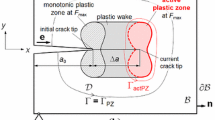Abstract
An energy dissipation rate concept is employed in conjunction with the J-integral to calculate crack growth resistance of elastic-plastic fracture. Different from Rice’s J-integral, the free energy density is employed in place of the stress working density to define an energy-momentum tensor, which yields that the slightly changed J-integral is path dependent regardless of incremental plasticity and deformational plasticity. The J-integral over the remote contour is split into the plastic influence term and the J FPZ-integral over the fracture process zone which is an appropriate estimate of the separation work of fracture. Finite element simulations are carried out to predict the plane strain mode I crack growth behavior by an embedded fracture process zone. It can be concluded that J-integral characterization is in essence a stress intensity-based fracture resistance similar to the K criterion of linear elastic fracture, and energy dissipation rate fracture resistance can be taken as an extension of the Griffith criterion to the elastic-plastic fracture.
Similar content being viewed by others
References
Orowan E.: Fatigue and fracture of metals. Wiley, New York (1952)
Irwin G.R.: Fracturing of metals, pp. 147–166. ASM, Cleveland (1949)
McClintock, F.A., Irwin, G.R.: Fracture toughness testing and its applications ASTM STP, 381 (1965)
Rice J.R., Sorensen E.P.: Continuing crack-tip deformation and fracture for plane-strain crack growth in elastic-plastic solids. J. Mech. Phys. Solids 26, 163–186 (1978)
Rice, J.R., Drugan, W.J., Sham, T.L.: Fracture Mechanics: 12th Conference-STP 700. p. 189. Philadelphia, PA (1980)
Dugdale D.S.: Yielding steel sheets containing slits. J. Mech. Phys. Solids 8, 100–104 (1960)
Barenblatt G.I.: Mathematical theory of equilibrium cracks in brittle fracture. Adv. Appl. Mech 7, 55–129 (1962)
Needleman A.: A continuum model for void nucleation by inclusion debonding. J. Appl. Mech. 54, 525–531 (1987)
Tvergaard V., Hutchinson J.W.: The relation between crack growth resistance and fracture process parameters in elastic-plastic solids. J. Mech. Phys. Solids 40, 1377–1397 (1992)
Gurson A.L.: Continuum theory of ductile rupture by void nucleation and growth—I. Yield criteria and flow rules for porous ductile media. J. Eng. Mater. Technol. 99, 2–15 (1977)
Tvergaard V., Needleman A.: Analysis of the cup–cone fracture in a round tensile bar. Acta Metal. 32, 157–169 (1984)
Tvergaard V.: Material failure by void growth to coalescence. Adv. Appl. Mech. 27, 83–151 (1990)
Siegmund T., Brocks W.: Prediction of the work of separation in ductile failure and implications to the modeling of ductile failure. Int. J. Fract. 99, 97–116 (1999)
Rousselier G.: Ductile fracture models and their potential in local approach of fracture. Nucl. Eng. Des. 105, 97–111 (1987)
Rousselier G.: Dissipation in porous metal plasticity and ductile fracture. J. Mech. Phys. Solids 49, 1727–1746 (2001)
Rice J.R.: A path independent integral and the approximate analysis of strain concentrations by notches and cracks. J. Appl. Mech. 35, 379–386 (1968)
Xia L., Shih C.F.: Ductile crack growth—I. A numerical study using computational cells with microstructurally-based length scales. J. Mech. Phys. Solids 43, 233–259 (1995)
Kishimoto K., Aoki S., Sakata M.: On the path independent integral (modified J integral in fracture mechanics). Eng. Fract. Mech. 13, 841–850 (1980)
Simha N.K., Fischer F.D., Shan G.X., Chen C.R, Kolednik O.: J-integral and crack driving force in elastic–plastic materials. J. Mech. Phys. Solids 56, 2876–2895 (2008)
Kolednik O.: On the physical meaning of the J-1a-curves. Eng. Fract. Mech. 38, 403–412 (1991)
Turner, C.E.: A re-assessment of ductile tearing resistance, part I: the geometry dependence of J–R curves in fully plastic bending. Eighth European Conference on Fracture, Warley, UK: EMAS 933–949 (1990)
Turner, C.E.: A re-assessment of ductile tearing resistance, part II: energy dissipation rate and associate R-curves on normalized axes. Eighth European Conference on Fracture, Warley, UK: EMAS 951–968 (1990)
Turner C.E., Kolednik O.: A micro and macro approach to the energy dissipation rate model of stable ductile crack growth. Fatig. Fract. Eng. Mater. Struct. 17, 1089–1107 (1994)
Kolednik O., Turner C.E.: Application of energy dissipation rate arguments to ductile instability. Fatig. Fract. Eng. Mater. Struct. 17, 1129–1145 (1994)
Siegmund T., Brocks W.: A numerical study on the correlation between the work of separation and the dissipation rate in ductile fracture. Eng. Fract. Mech. 67, 139–154 (2000)
Memhard D., Brocks W., Fricke S.: Characterization of ductile tearing resistance by energy dissipation rate. Fatig. Fract. Eng. Mater. Struct. 16, 1109–1124 (1993)
Sumpter J.D.G.: An alternative view of R curve testing. Eng. Fract. Mech. 64, 161–176 (1999)
Tvergaard V.: Influence of voids on shear band instabilities under plane strain conditions. Int. J. Fract. 17, 389–407 (1981)
Tvergaard V.: On localization in ductile materials containing voids. Int. J. Fract. 18, 237–251 (1982)
Brown, L.M., Embury, J.D.: The initiation and growth of voids at second phase . In: Proceedings of the 3rd International Conference on Strength of Metals and Alloys, Institute of Metals, pp. 164–169. London (1973)
Goods S.H., Brown L.M.: The nucleation of cavities by plastic deformation. Acta Metal. 27, 1–15 (1979)
Andersson H.: Analysis of a model for void growth and coalescence ahead of a moving crack tip. J. Mech. Phys. Solids 25, 217–233 (1977)
Ziegler H.: An Introduction to Thermomechanics, 1st edn. North Holland, Amsterdam (1983)
Lemaitre J., Chaboche J.L.: Mechanics of Solid Materials. Cambridge University Press, Cambridge (1990)
Gurtin M.E., Podio-Guidugli P.: Configurational forces and the basic laws for crack propagation. J. Mech. Phys. Solids 44, 905–927 (1996)
Gurtin M.E.: The nature of configurational forces. Arch. Ration. Mech. Anal. 131, 67–100 (1995)
Ortiz M., Pandolfi A.: Finite-deformation irreversible cohesive elements for three-dimensional crack-propagation analysis. Int. J. Numer. Methods Eng. 44, 1267–1282 (1999)
Author information
Authors and Affiliations
Corresponding author
Rights and permissions
About this article
Cite this article
He, Q.L., Wu, L., Li, M. et al. Prediction of mode I crack growth resistance based on a comparative investigation of J-integral and energy dissipation rate concept. Acta Mech 215, 175–191 (2010). https://doi.org/10.1007/s00707-010-0329-2
Received:
Revised:
Published:
Issue Date:
DOI: https://doi.org/10.1007/s00707-010-0329-2




